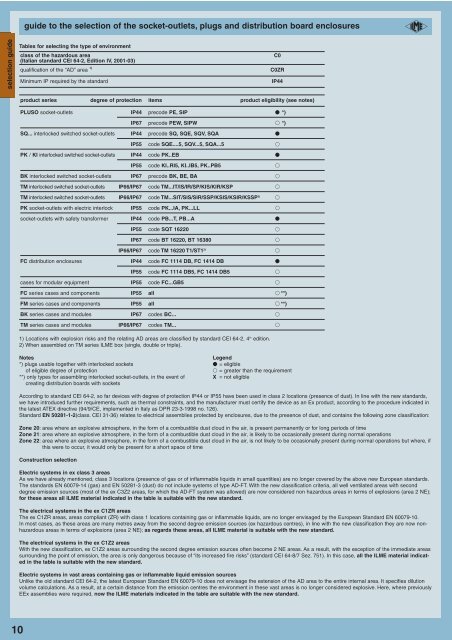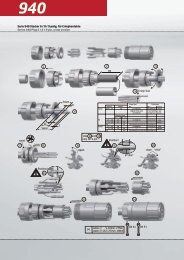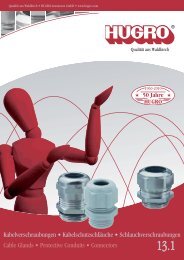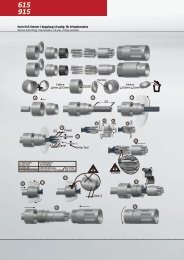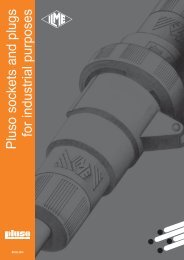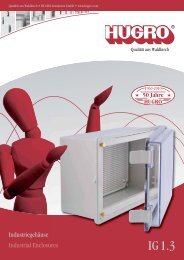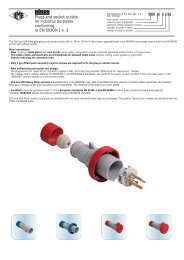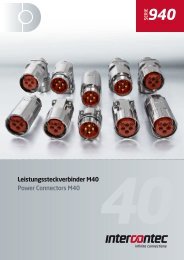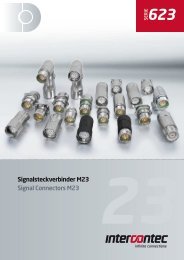guide to the selection of the socket-outlets, plugs and distribution board enclosuresUse in electric systems in areas at risk of explosionThe electric systems which have come into existence since 1-7-2003 in work areas at risk of explosion due to the presence of gas, fumes, smoke or dangerous powders (excludingmines) must comply with European Directive 99/92/EC (a.k.a. ATEX 137). This is the so called ”social” part of the ATEX Directive 1) , adopted within the general directive89/391/EC on the subject of safety at work, implemented in Italy as the well know Law Decree n. 626/94 which merged with Law Decree n. 233/03 under Title VIII-bis.According to this directive (art. 8) employers must, among other things, develop and keep up to date the “Document regarding protection against explosions” in which they muststate:- that all explosion risks have been identified;- what measures will be taken to avoid the danger of explosions;- that the zones have been identified and classified (table A);- that the work equipment is suited to the type of area and that it is used and maintained in adequate working order. The Directive specifies (art. 9) the implementation timescale:The minimum provisions of Attachment II, part A apply to any equipment already existing as at 30-6-2003; as regards work areas already in use as at 30-6-2003, said minimumprovisions must be adapted by 30-6-2006. Finally, compliance with the provisions of Attachment II, Part A + B 2) is required as regards equipment purchased after 30-6-2003 andnew work areas in which explosive atmospheres may form.The Directive does not apply to medical areas, gas equipment, explosive substances, mines and land, river or air transport vehicles (vehicles intended for use in explosive atmospheresare not excluded).As regards equipment installed in the abovementioned locations, as from 1-7-2003 these must comply with Directive 94/9/EC (a.k.a. ATEX 95 and implemented in Italy asPresidential Decree n. 126 dated 23-3-1998). This applies to all equipment and protection systems intended for use in potentially explosive atmospheres (including mines). Twoequipment groups are envisaged: group 1, intended for underground mine use or for overground mine works (firedamp and/or combustible dust); group 2, all other locations.Attachment 1 of Directive 94/9/EC defines categories M 1 and M 2 for group 1 equipment, and the following three categories for group 2 equipment:- category 1 equipment (very high level of protection - zones 0 or 20);- category 2 equipment (high level of protection - zones 1 or 21);- category 3 equipment (normal level of protection - zones 2 or 22);Ex material sold or installed after 30-6-2003 must be marked EC and be accompanied by the EC conformity declaration, on the basis of this directive.selection guideStandard CEI 64-2 (1990-11, 4 th edition, Booklet 1431) governed applications in locations at risk of explosions in a mainly industrial context. So far the following EuropeanStandards have been published in an effort to harmonise said standard throughout Europe:HAZARDOUS AREAS DUE TO THE PRESENCE OF INFLAMMABLE FUMES OR GAS (ex class C1 and C3 areas)- CEI EN 60079-10 (2004-01, class CEI 31-30, 2 rd Ed.) “Electrical assemblies aimed at explosive atmospheres due to the presence of gas - Part 10: Classification of hazardouslocations”, in force, regarding the classification of hazardous places due to the presence of inflammable fumes or gas 3) ;- CEI EN 60079-14 (2004-05, class CEI 31-33) ”Electrical assemblies aimed at explosive atmospheres due to the presence of gas - Part 14: Electrical systems in areas at riskof explosions due to the presence of gas (other than mines)” in force, regarding provisions concerning electrical systems in areas at risk of explosion due to the presence ofgas (other than mines) 4) ;HAZARDOUS AREAS DUE TO THE PRESENCE OF COMBUSTIBLE DUST (ex class C2 areas)- CEI EN 50281-3 (2003-06, class CEI 31-52) ”Assemblies aimed at explosive atmospheres due to the presence of combustible dust - Part 3: Classification of areas where combustibledust is or could be present”, in force since 1-7-2003, regarding the ex class C2 areas of standard CEI 64-2 5)- CEI EN 50281-1-2 (1999-09, class CEI 31-36) called “Electrical assemblies aimed at explosive atmospheres due to the presence of combustible dust - Part 1-2: Electricalassemblies protected by enclosures - Selection, installation and maintenance”, definitively in force since 1-7-2003 6)These are the first of a large collection of CENLEC standards regarding electrical systems in areas at risk of explosion. They will be followed by other standards regarding theclassification of actually or potentially explosive areas due to the presence of explosives (ex class C0 area of standard CEI 64-2) and by standards regarding the safety requirementsof relating electrical systems, currently being developed by IEC and CENELEC. In particular, as from 1-1-1998 the definition of class C1 and C3 areas containing inflammablesubstances such as gas or inflammable liquids - i.e. excluding inflammable dust (class C2) and explosives (class C0) - is no longer in force: the relating chapters 3 and 5of standard CEI 64-2 have been abolished and replaced by the abovementioned standard CEI EN 60079-10. This introduces zone classifications, thus replacing the existingquantitative differentiation by a more analytical approach based on the degree of emission (three levels: continuous, primary or secondary) and on the degree of ventilation (threelevels: high, medium or low, with three further sublevels: good, average or poor). Zone extensions are determined through application guidelines and calculations.Zone 0: area with a continuous or prolonged explosive atmosphere due to the presence of gasZone 1: area where an explosive atmosphere due to the presence of gas may occur in normal operational conditionsZone 2: area where it is impossible for an explosive atmosphere due to the presence of gas to occur in normal operational conditions or where, should this occur, it may onlyoccur infrequently and for short spaces of time. Standard CEI EN 60079-14 replaced standard CEI 64-2 as regards the requirements of the electrical systems installed in areascontaining gas or inflammable liquids. In particular, since 30-11-1999 it has abolished chapters VII (AD-PE systems), VIII (AD-SI systems), IX (AD-I systems), XI (AD-FE systems)and XIII (AD-S systems), resulting therefore in the disappearance of the above types of safety electrical systems as described and defined by standard CEI 64-2. StandardCEI EN 50281-3 (2003-06, 1 st ed.) resulted in the further abolishment of chapter IV of standard CEI 64-2 7) , with standard EN 50281-1-2 (1999-09, 1 st ed.) substituting all parts ofthe chapters I, II, VI, X, XII and XIV regarding provisions for areas where combustible dust is or may be present (class C2 areas). Therefore only chapters I, II, VI, X, XII and XIVof standard CEI 64-2 remain in force, concerning specific provisions for the presence or development of explosive substances (class C0) while awaiting corresponding Europeanstandards.Standard CEI 64-2/A was abolished in 1-9-2001 with the publication of Guides CEI 31-35 (2001-01, 2 nd ed.) and CEI 31-35/A (2001-01, 2 nd ed.).Therefore it is no longer possible to use withstanding functional safety systems (AD-FT) in ex C2 areas (ex chapter XII).Most of the situations that used to allow this installation solution are classified as non-explosive (NE), in line with the new area classification. Therefore, in thesecases no particular adjustment is required either for new systems or for those existing before 30-6-2003, as these do not fall within Ex zone classifications in linewith the latest ATEX directives.As regards areas that would now need to be classified as Ex in line with the abovementioned ATEX Directive 137 (99/92/EC) in force since 1-7-2003, such as zone 2 or 22, newsystems require category 3 Ex electrical material, whereas systems existing before 30-6-2003 need to be adapted using said ATEX certified material by 30-6-2006.Given that in any case existing electrical systems constructed in line with the provisions of standard CEI 64-2 provide the same level of safety as those constructed in line withthe new standard CEI EN 60079-14, the table below contains indications for selecting AD-FT system components, exclusively for class C0 areas (presence of explosive substances),as inferred from standard CEI 64-2. Said table will remain valid until the publication of standards that abolish chapters I, II, VI, X, XII and XIV regarding said areas.1) ATEX = ATmosphere Explosive.2) Attachment II - Part B = equipment category selection criteria on the basis of the zone classification: zones 0 or 20 require category 1 equipment; zones 1 or 21 require category1 or 2 equipment; zones 2 or 22 require category 1, 2, or 3 equipment.3) The 1 st 1996-10 edition, in force since 1-11-1996, will remain simultaneously in force until 1-10-05.4) The 1 st 1998-01 edition, in force since 1-03-1998, will remain simultaneously in force until 1-6-06.5) Should be replaced with the European Standard prEN 61241-10 project ”Electrical apparatus for use in the presence of combustible dust - Part 10: Classification of areaswhere combustible dust is or may be present”, based on a similar IEC project.6) Integrated by amendment EN 50281-1-2/A1 (2004-06), it should be replaced by the European Standard prEN 61241-14 project ”Electrical apparatus for use in the presenceof combustible dust - Part 14: Selection and installation”7) Already reprinted by the CEI in March 2001, once again as 4 th edition, Booklet 5964 C.9
guide to the selection of the socket-outlets, plugs and distribution board enclosuresselection guideTables for selecting the type of environmentclass of the hazardous area(Italian standard CEI 64-2, Edition IV, 2001-03)qualification of the “AD” area 1)Minimum IP required by the standardC0C0ZRIP44product series degree of protection items product eligibility (see notes)PLUSO socket-outlets IP44 precode PE, SIP *)IP67 precode PEW, SIPW *)SQ... interlocked switched socket-outlets IP44 precode SQ, SQE, SQV, SQA IP55 code SQE....5, SQV...5, SQA...5 PK / KI interlocked switched socket-outlets IP44 code PK..EB IP55 code KI..RI5, KI..IB5, PK..PB5 BK interlocked switched socket-outlets IP67 precode BK, BE, BA <strong>TM</strong> interlocked switched socket-outlets IP66/IP67 code <strong>TM</strong>...IT/IS/IR/SP/KIS/KIR/KSP <strong>TM</strong> interlocked switched socket-outlets IP66/IP67 code <strong>TM</strong>...SIT/SIS/SIR/SSP/KSIS/KSIR/KSSP 2) PK socket-outlets with electric interlock IP55 code PK...IA, PK...LL socket-outlets with safety transformer IP44 code PB...T, PB...A IP55 code SQT 16220 IP67 code BT 16220, BT 16380 IP66/IP67 code <strong>TM</strong> 16220 T1/ST1 2) FC distribution enclosures IP44 code FC 1114 DB, FC 1414 DB IP55 code FC 1114 DB5, FC 1414 DB5 cases for modular equipment IP55 code FC...GB5 FC series cases and components IP55 all **)FM series cases and components IP55 all **)BK series cases and modules IP67 codes BC... <strong>TM</strong> series cases and modules IP66/IP67 codes <strong>TM</strong>... 1) Locations with explosion risks and the relating AD areas are classified by standard CEI 64-2, 4 th edition.2) When assembled on <strong>TM</strong> series ILME box (single, double or triple).NotesLegend*) plugs usable together with interlocked sockets = eligibleof eligible degree of protection = greater than the requirement**) only types for assembling interlocked socket-outlets, in the event of X = not eligiblecreating distribution boards with socketsAccording to standard CEI 64-2, so far devices with degree of protection IP44 or IP55 have been used in class 2 locations (presence of dust). In line with the new standards,we have introduced further requirements, such as thermal constraints, and the manufacturer must certify the device as an Ex product, according to the procedure indicated inthe latest ATEX directive (94/9/CE, implemented in Italy as DPR 23-3-1998 no. 126).Standard EN 50281-1-2(class. CEI 31-36) relates to electrical assemblies protected by enclosures, due to the presence of dust, and contains the following zone classification:Zone 20: area where an explosive atmosphere, in the form of a combustible dust cloud in the air, is present permanently or for long periods of timeZone 21: area where an explosive atmosphere, in the form of a combustible dust cloud in the air, is likely to be occasionally present during normal operationsZone 22: area where an explosive atmosphere, in the form of a combustible dust cloud in the air, is not likely to be occasionally present during normal operations but where, ifthis were to occur, it would only be present for a short space of timeConstruction selectionElectric systems in ex class 3 areasAs we have already mentioned, class 3 locations (presence of gas or of inflammable liquids in small quantities) are no longer covered by the above new European standards.The standards EN 60079-14 (gas) and EN 50281-3 (dust) do not include systems of type AD-FT. With the new classification criteria, all well ventilated areas with seconddegree emission sources (most of the ex C3Z2 areas, for which the AD-FT system was allowed) are now considered non hazardous areas in terms of explosions (area 2 NE);for these areas all ILME material indicated in the table is suitable with the new standard.The electrical systems in the ex C1ZR areasThe ex C1ZR areas, areas compliant (ZR) with class 1 locations containing gas or inflammable liquids, are no longer envisaged by the European Standard EN 60079-10.In most cases, as these areas are many metres away from the second degree emission sources (ex hazardous centres), in line with the new classification they are now nonhazardousareas in terms of explosions (area 2 NE); as regards these areas, all ILME material is suitable with the new standard.The electrical systems in the ex C1Z2 areasWith the new classification, ex C1Z2 areas surrounding the second degree emission sources often become 2 NE areas. As a result, with the exception of the immediate areassurrounding the point of emission, the area is only dangerous because of “its increased fire risks” (standard CEI 64-8/7 Sez. 751). In this case, all the ILME material indicatedin the table is suitable with the new standard.Electric systems in vast areas containing gas or inflammable liquid emission sourcesUnlike the old standard CEI 64-2, the latest European Standard EN 60079-10 does not envisage the extension of the AD area to the entire internal area. It specifies dilutionvolume calculations. As a result, at a certain distance from the emission centres the environment in these vast areas is no longer considered explosive. Here, where previouslyEEx assemblies were required, now the ILME materials indicated in the table are suitable with the new standard.10


